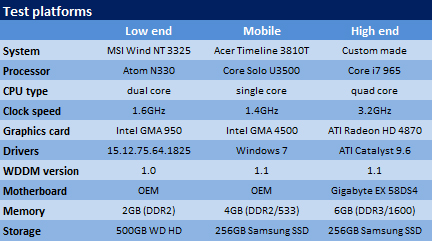Benchmarks: Windows 7 RTM versus Vista, XP

Windows Vista's less than stellar reputation and poor uptake are due in large part to the heavy demands it makes on system hardware. When Vista appeared in the autumn of 2006, PCs and notebooks were less powerful than today's machines. But even with modern hardware, anyone using a Vista-based system soon senses that this is an operating system suffering from the software equivalent of having the handbrake left on.
Microsoft cannot afford a repetition with Windows 7, and so has optimised all of the OS's major system components. From startup to login, everything in Windows 7 is faster.
Microsoft has now finalised Windows 7 and announced its Release To Manufacturing (RTM). Build 7600.1685 has been chosen for the RTM, and ZDNet used this version test the performance of Windows 7 against Vista and XP on various platforms.

Startup and shutdown
The time it takes an operating system to start up is not crucially important for performance — after all, you usually only start up once a day. However, it provides a first indication of the OS's speed. The same is true for the shutdown process.
Before testing got under way, all available updates were freshly installed on the operating systems. To maximise disk performance, AHCI mode was enabled in the BIOS.
On our high-end test system using a PM800-series Samsung solid-state drive (SSD), Windows 7 takes just 12 seconds to bring up the desktop. XP takes 14.1 seconds and Vista 14.5 seconds.
However, experienced Windows users know that the time it takes for the desktop to appear and the full launch of the operating system are not the same thing. So we took a second measurement, stopping the clock at the launch of Internet Explorer 8 and the Bing search homepage. This gives an idea of how long it takes before you can use an internet-based application.
To judge by this measurement, Windows 7 gets to work quickly. After the appearance of the desktop it takes only a further 2.5 seconds to display the Bing homepage. The whole startup process for Windows 7 up to the appearance of Bing takes 14.5 seconds. Vista takes 18.5 seconds and XP 23.7 seconds.
Windows 7 also shuts down quicker than its two predecessors, taking just 4.5 seconds compared with seven seconds for Vista and 6.5 seconds for XP.
Startup on the low-end system naturally takes longer. The launch of Windows 7 on a system with a 1.6GHz Intel Atom N330 processor and a conventional hard disk took 44 seconds. Windows 7 connected to the internet after a further 3 seconds, compared with 57 seconds for Vista and 55 seconds for XP. On the low-end system, shutdown is fastest under XP at 8.1 seconds, against Windows 7's 9.1 seconds and Vista's 10.3 seconds.
Overall, the startup and shutdown timings show that Windows 7 performs best, regardless of the specification of the system it's running on. However, updates and application installations may alter those timings.
Timings in seconds: shorter bars are better.
Memory management and cache usage
With Vista, Microsoft introduced a new technology called SuperFetch for caching applications and speeding up boot times. This feature preloads frequently-used applications into memory, so they can be accessed quicker when they're needed.
For conventional magnetic hard drives, this technology makes sense. But if an SSD is used for mass storage, it's better to turn SuperFetch off. The superior access times of SSDs mean they launch applications much faster than magnetic drives, so SuperFetch makes little difference.
Microsoft indicated in a blog entry in May that Windows 7 would disable SuperFetch on systems using SSDs. The company also said that other features such as Defrag and ReadyBoost would not be used under Windows 7. However, in the RTM version (7600.16385), only Defrag is in fact inactive for SSDs — SuperFetch and ReadyBoost start just as they would with a magnetic disk.
The SuperFetch feature in Windows 7 differs significantly in approach and cache usage from its counterpart in Vista. Under Vista, the caching of applications starts immediately at launch. As the graph below shows, after three minutes just over 1GB of memory has been allocated. In Windows 7, SuperFetch starts after five minutes and after 10 minutes a little more than 600MB has been allocated. By that point, Vista's SuperFetch has allocated more than 1.5GB.
Even without SuperFetch turned on, Windows 7 makes fewer demands on cache. For operating system-related functions, it uses 333MB, while Vista without SuperFetch uses 519MB of cache.
The new implementation of SuperFetch under Windows 7 has a positive impact on performance. Windows 7 clearly makes do with fewer resources, so its cache usage is significantly lower than Vista's. SuperFetch also starts much later, so the hard drive is not tied up immediately after the launch of the operating system. That means you don't have to wait while the operating system monopolises system resources for its caching tasks.
Application performance: PCMark Vantage
PCMark Vantage tests system performance by benchmarking the applications that are integrated into Vista and Windows 7. The benchmark is divided into several usage scenarios, with the default PCMark Suite simulating everyday PC usage. Here's a list of the individual tests:
- Memories: Four tests check the speed of Windows Photo Gallery and Windows Movie Maker when handling photos and video.
- TV and Movies: Plays and converts high-definition video in four separate tests.
- Gaming: Measures the performance of the graphics card and estimates the loading speed of compressed game data.
- Music: Converts WAV music files to MP3 and WMA Lossless formats and adds music files in Media Player.
- Communication: Tests include web-page rendering, CNG AES CBC encryption, Windows Mail Search and audio transcoding.
- Productivity: Tests include text editing, search in Windows Contacts, analysis of the boot process and web-page rendering.
- HDD: Disk performance is measured using Windows Defender, Windows Photo Gallery, Windows Movie Maker, Windows Media Center and Windows Media Player. The disk's speed when launching the operating system and applications is also measured.
More information about PCMark Vantage is available in this white paper. We used the 64-bit version with default settings, running the tests three times and presenting the average values.
The graphs below show that the integrated applications in Windows 7 perform better than their Vista counterparts. This result is even more pronounced on the mobile platform (single-core Acer Timeline 3810T notebook) than the high-end system (Core i7-based desktop). The mobile platform shows an average performance increase of 35 percent under Windows 7, while the high-end desktop is 20 percent faster.
The music applications benefit most from the new operating system, showing a 64 percent performance improvement. The individual tests reveal that the conversion of WAV files to WMA Lossless is now three times faster.
It would be unwise to conclude that every application will work 20 percent faster under Windows 7 on average. Remember that PCMark Vantage is only testing the integrated Windows applications — Windows 7's performance advantage over Vista, if any, will depend on the mix of applications you use.
Other tests such as Everest, 7-zip, 3DMark Vantage, Cinebench and Paint.Net suggest that Windows 7 is not faster than Vista. Even so, an increase in the performance of the integrated applications in Windows is not a trivial advantage.
PCMark score: longer bars are better.
Conclusion
Windows 7 performs better than Vista and is also faster than XP, although XP remains more capable for devices with limited memory and outdated graphics.
Subjectively, the change from Vista to Windows 7 is like releasing a car's handbrake. This significant increase in performance has several causes: faster system startup and shutdown compared to XP and Vista; improved parallel processing; and faster loading of drivers and operating system components. Enterprise users will also appreciate the faster login to a domain.
Microsoft has also thoroughly revised the SuperFetch feature, which results in quicker operational readiness after startup. Anyone migrating from Vista will notice a reduction in disk activity after startup, because SuperFetch spends less time loading applications into memory in Windows 7, which means less waiting for the system to be ready to use after launch.
Windows 7 is more cache-frugal thanks to improved display drivers. No matter how many windows are open, the memory usage of the Desktop Window Manager (DWM) remains constant, the video card's memory taking on the load of opening of additional windows. However, under Windows 7 this load is half what it was with Vista. Windows 7 also introduces Direct2D, which further speeds up 2D graphics rendering. However, the standard WDDM 1.1 driver is required to enjoy the improved 2D graphics performance. For graphics cards containing ATI and Nvidia chips, this is not an issue, since a driver has existed for a long time. However, these drivers are not yet available for older Intel graphics chipsets.
Users can employ the built-in Windows 7 DirectX 11 interface to access the graphics power of the GPU (Compute Shader) using appropriate graphics hardware. This feature could prove particularly useful to those who provide video-encoding tools. However, there are still no third-party products that support this new standard.
In Windows 7, Microsoft has succeeded in providing an OS that's likely to meet the performance requirements of consumers and business users alike. The early signs are that Windows 7 will enjoy a much better take-up than Vista. Of our three test platforms, only the low-end Intel Atom-based system is not really suitable for Windows 7. But even a single-core processor such as a 1.4GHz Core 2 Solo is sufficient to deliver smooth performance under Windows 7. High-end systems with quad-core processors also benefit from Windows 7, because many of the operating system functions exploit the computing power of multi-core chips.